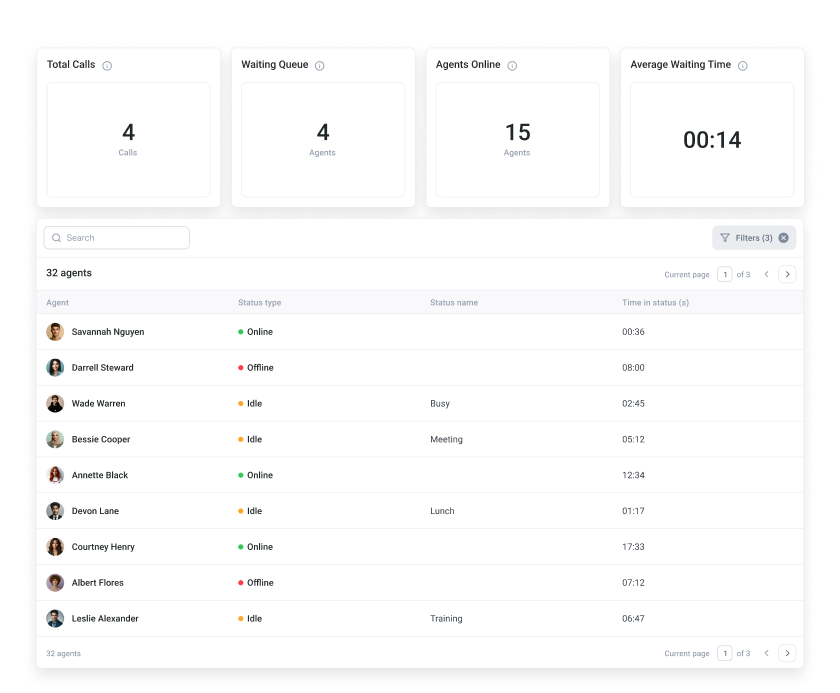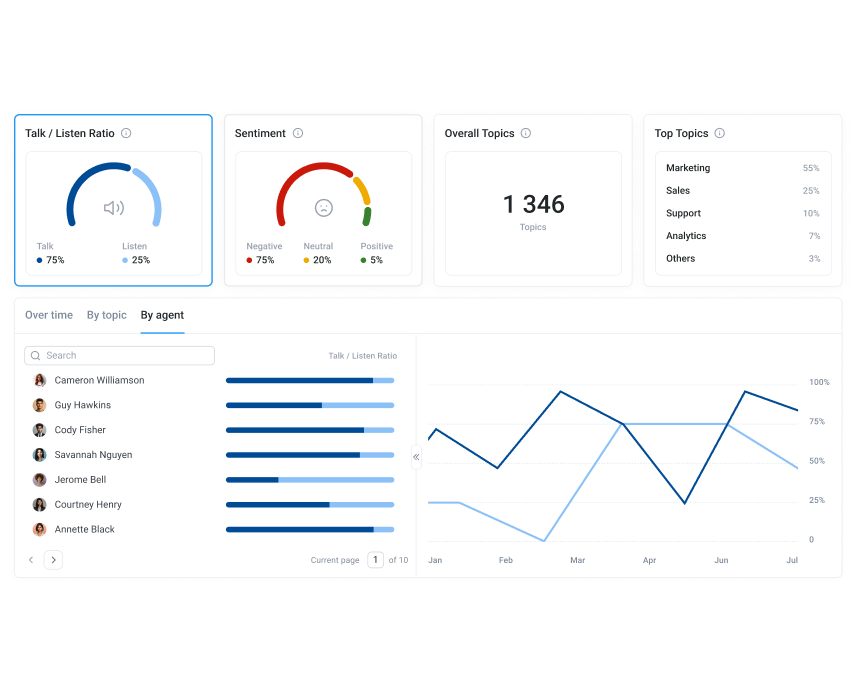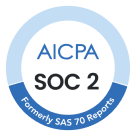
Your sales team just landed a massive deal that could take your company to the next level. Excitement is in the air. Until you realize you can’t fulfill the order on time.
Finance scrambles to adjust the budget, but without accurate demand planning, resources are stretched too thin. The result? Delayed shipments, frustrated customers, and lost revenue.
This scenario is all too common in businesses that lack a structured sales and operations planning process. They often struggle with data fragmentation, siloed decision-making, and forecasting blind spots—making it difficult to scale efficiently.
The solution? A well-defined S&OP framework that aligns sales forecasts with supply chain capabilities, financial resources, and operational execution. And in B2B sales experience, real-time data integration is the missing puzzle piece that can transform reactive decision-making into proactive strategy.
Let’s walk through how you can build an effective S&OP process that bridges the gap between ambition and execution.
Key Takeaways:
- An S&OP framework aligns sales, supply chain, and financial strategies to ensure businesses meet demand efficiently.
- Overcoming common challenges, like data fragmentation and lack of agility, requires real-time insights and seamless collaboration.
- Integrated AI calling software like CloudTalk enhances S&OP by integrating real-time call data, improving communication, and providing analytics for better forecasting.
Start optimizing your planning process today
Definition of Sales & Operations Planning (S&OP)
Sales & operations planning (S&OP) is a strategic process that aligns sales, supply chain, and financial plans to optimize business performance. It helps companies balance supply and demand, minimize costs, and improve profitability.
pro tip
Pro tip: Explore CloudTalk’s real-time data integration and see how it can transform your S&OP process.
Sales & Operations Planning Process: A Step-by-Step Guide
You and your team are working hard to prevent another near-miss. But where do you start? You need a system that bridges the gap between sales forecasts, supply chain execution, and financial planning—one that provides real-time insights and allows departments to collaborate easily.
An effective S&OP process requires structured planning, accurate data, and seamless collaboration. These five key steps will help you build a robust framework:
1. Gather and Analyze Sales and Demand Data
Every great plan starts with accurate insights. Without understanding customer demand trends, businesses risk stockouts, overproduction, or financial strain.
To build a reliable forecast, you’ll need to collect sales data, analyze market trends, and gather customer insights from multiple touchpoints. Historical CRM reports and AI-driven analytics can identify patterns in past sales performance, leading to a better understanding of trends.
Plus, using an omnichannel contact center allows businesses to unify customer interactions across various communication channels. This provides a more comprehensive view of demand trends and helps teams make data-informed decisions.
2. Align Supply Planning with Demand Forecasts
A demand forecast is only as valuable as a business’s ability to fulfill it, making supply planning a crucial component of the S&OP process.
To ensure smooth operations, you need to synchronize inventory levels with projected demand, balancing stock availability to avoid costly stockouts or excessive overproduction. Integrated business planning tools can help different departments stay aligned, ensuring procurement and production meet changing demands.
With CloudTalk’s customer interaction data, you can refine supply chain planning based on actual sales conversations, ensuring production aligns with real-world demand patterns.
3. Strengthen Cross-Functional Collaboration
S&OP success depends on eliminating silos and fostering collaboration between departments. When sales, operations, finance, and supply chain teams operate in sync, businesses can avoid misaligned goals, resource shortages, and unnecessary bottlenecks.
Utilizing tools like a staff shift planner app helps coordinate team schedules, ensuring staffing levels align with demand forecasts and operational needs. This promotes smoother workflows and better resource allocation across departments.
Regular cross-functional meetings help ensure all stakeholders contribute ideas and agree on important decisions.
CloudTalk streamlines collaboration by centralizing communication inputs, Call Analytics, voicemail, and internal team messaging. With better communication and shared visibility, teams can work cohesively to adjust forecasts, allocate resources efficiently, and anticipate potential challenges before they arise.
4. Assess Financial Risks and Budget Impact
S&OP isn’t just about operational efficiency or supply chain management. It’s also a strategic planning process that ensures sustainable growth. Market fluctuations, supply chain disruptions, or shifts in customer demand can create significant financial risks, making it essential to assess these factors before finalizing any plan.
Early risk identification helps businesses align budgets and revenue targets with revenue goals and operational limits, ensuring efficient resource allocation. This level of financial oversight helps you maintain cost control while adapting quickly to changing market conditions. S&OP software can help automate financial modeling, making risk assessment faster and more precise.
5. Execute, Monitor, and Continuously Improve
Creating an S&OP is only the first part of the process. From here, you’ll need to continuously monitor and adjust your plan to ensure it stays relevant. Clear KPIs can help you measure success so that you can track progress and identify areas for improvement.
Performance analytics play a key role in this process, providing the necessary insights to adjust strategies and optimize future planning cycles. CloudTalk’s Call Analytics and reporting tools allow you to monitor key sales and customer engagement metrics, providing valuable data to enhance decision-making.
Continuous improvement and real-time data help you adapt your sales and operations planning to a changing market.
Challenges in S&OP and How to Overcome Them
You built what looks like a solid S&OP. Forecasts are in place, supply planning looks great, and you scheduled all the meetings. Yet, when the next big deal comes through, familiar issues resurface. Sales have different numbers than operations, finance is working with outdated budgets, and decision-making stalls because no one seems to have a single, reliable source of truth. How’s that possible?
An A&M study revealed that while approximately 70% of companies have adopted a formal S&OP process, only about 25% have implemented it fully and consistently across their organization. That’s because even with a structured process, businesses often hit roadblocks.
Here’s how to navigate the most common S&OP challenges.
1. Data Silos & Lack of Visibility
When sales, operations, and finance use separate tools, data fragmentation leads to miscommunication, delays, and inaccurate planning. Sales teams track customer interactions in CRMs, while supply chain and finance rely on ERP and budgeting tools, making it difficult to get a unified view of demand.
To fix this, you need to centralize your data using real-time integrations between your existing CRM, ERP, and other business tools to provide a single source of truth. CloudTalk combines seamlessly with these platforms, ensuring that sales, customer, and operational data are unified in one place.
This integration provides better visibility, enabling faster decision-making and more accurate forecasts without the inefficiencies of siloed systems.
2. Inaccurate Demand Forecasting
Forecasting errors result in either excess inventory or missed revenue. Many businesses rely on manual data gathering, outdated models, or incomplete data, leading to unreliable projections. External factors like market shifts and seasonality further complicate predictions.
Using AI-driven analytics and historical sales data improves forecasting accuracy by identifying demand patterns. CloudTalk’s Call Analytics provides an additional layer of insight, helping you predict demand based on real customer interactions.
3. Resistance to Cross-Functional Collaboration
S&OP requires alignment across teams, but competing priorities create silos. Sales pushes for growth, operations prioritizes efficiency, and finance focuses on cost control, leading to misaligned strategies and slow decision-making.
To foster collaboration, establish shared KPIs that align department goals with overall strategy. CloudTalk’s features, such as Wallboard, Agent Status, or a Real-Time Dashboard, help teams stay informed and aligned by sharing key agent updates, call metrics, and availability. Regular S&OP meetings and scenario planning further encourage cross-functional decision-making.

4. Lack of Agility in Adjusting Plans
Markets shift, customer needs change, and supply chains face disruptions, yet many businesses rely on rigid supply chain planning models that prevent quick adjustments. Without real-time insights, companies struggle to adapt.
Adopting cloud-based planning tools enables real-time scenario modeling, allowing businesses to pivot based on evolving conditions. CloudTalk’s real-time data helps teams make informed adjustments, ensuring S&OP remains dynamic and responsive to market shifts.
Industry-Specific Considerations in S&OP
After identifying weak spots in your S&OP, you might realize a one-size-fits-all approach doesn’t work. The challenges a software company faces aren’t the same as those in financial services or education. A tech startup struggling with unpredictable subscriptions will need a different approach than a consulting firm managing project-based workloads.
How to tailor your approach for your business? Here are a few considerations.
Software & Tech
The software industry faces fluctuating demand cycles driven by product launches, subscription renewals, and evolving customer needs. Cloud-based services require businesses to scale infrastructure quickly while avoiding unnecessary costs.
Without an efficient sales and operations planning process, companies risk overestimating demand, leading to excess server capacity, or underestimating it, causing performance issues.
To create a better S&OP, you can use subscription-based analytics that track renewal trends, customer usage, and churn risk. Real-time insights from tools like CloudTalk’s Call Analytics help predict shifts in demand by analyzing customer inquiries, support requests, and feedback, allowing you to optimize sales and resource allocation.

Financial Services
Financial institutions must balance sales growth, regulatory compliance, and market volatility. Seasonal shifts, economic fluctuations, and interest rate changes impact customer demand, requiring precise forecasting. Poor planning can lead to over-staffing during slow periods or capacity shortages when transaction volumes peak.
Real-time data and analytics can help you predict demand changes and optimize resources. With CloudTalk’s call data and customer interaction tracking, you can identify trends, like increased demand for financial services during tax season, which helps maintain efficient and compliant operations. Additional data can be collected by financial platforms issuing business credit cards to determine patterns in business spending and adjust their offering by optimizing their processes for business credit card applications.
Professional Services
Consulting firms, legal practices, and agencies must juggle client contracts, resource availability, and project deadlines. Misaligned planning can cause overbooking, underutilized talent, or missed revenue opportunities. Demand is often project-based, making it difficult to predict resource needs accurately.
Predictive workforce planning tools help firms match staffing levels with project demand while reducing inefficiencies. CloudTalk’s features, such as Call Monitoring and CRM integrations, provide valuable insights into client inquiries and service demand, allowing you to allocate resources more effectively and maintain high service levels.
For example, a consulting firm using CloudTalk’s Call Monitoring feature can track the volume and nature of client inquiries in real-time, identifying trends in service demand. If a surge in calls about compliance consulting emerges, managers can adjust staffing levels and relocate resources before bottlenecks arise.
Meanwhile, a CRM integration ensures all team members have access to the latest client interactions, helping them prepare for engagement efficiently, and preventing missed follow-ups.

Education & E-learning
Schools, universities, and online learning platforms face seasonal fluctuations, requiring institutions to scale digital infrastructure, staffing, and content distribution accordingly. Poor planning can lead to system overloads during peak enrollment or underutilized resources in off-seasons.
Real-time engagement data helps institutions improve their courses and infrastructure. CloudTalk’s Analytics can help track student interactions, support requests, and enrollment inquiries, providing insights to predict demand, boost course accessibility, and improve learning experiences.
By analyzing when and where inquiries peak, you can adjust staffing levels, streamline admissions processes, and ensure timely follow-ups to maximize enrollment opportunities. This data-driven approach helps predict demand, boosts course accessibility, and improves learning experiences.
Sales & Operations Planning (S&OP) Template
To help you streamline your S&OP efforts, we’ve designed a comprehensive template that covers every key aspect of planning, from demand forecasting and supply management to financial assessment and cross-functional collaboration.
This template will guide you through defining business objectives, analyzing sales data, aligning supply with projected demand, and monitoring key performance indicators.
Whether you’re implementing S&OP for the first time or refining an existing process, this template ensures that all departments stay on the same page. This can lead to better forecasting accuracy, reduced risks, and better decision-making.
1. Business Overview
Company Name: [Enter your company name]
Reporting Period: [Month/Quarter/Year]
S&OP Meeting Date: [Date of planning review]
2. Demand Forecasting
Product/
Service
Previous Sales (Units)
Current Forecast (Units)
Growth %
Key Market Trends
[Product A]
[Enter value]
[Enter value]
[Enter %]
[Notes]
[Product B]
[Enter value]
[Enter value]
[Enter %]
[Notes]
Key Assumptions:
- [List demand assumptions, e.g., seasonal trends, market changes, or new product launches]
3. Supply & Inventory Planning
Product/
Service
Current Inventory
Forecasted Demand
Production Plan
Shortage/Surplus Risk
[Product A]
[Enter value]
[Enter value]
[Enter production plan]
[Risk assessment]
[Product B]
[Enter value]
[Enter value]
[Enter production plan]
[Risk assessment]
Actions to Mitigate Supply Risks:
- [Enter planned adjustments, such as supplier diversification or inventory buffers]
4. Financial & Budget Assessment
Metric
Previous Period
Current Forecast
Variance %
Notes
Revenue ($)
[Enter value]
[Enter value]
[Enter %]
[Notes]
Operating Costs ($)
[Enter value]
[Enter value]
[Enter %]
[Notes]
Profit Margin (%)
[Enter value]
[Enter value]
[Enter %]
[Notes]
Cost-Saving Opportunities:
- [List actions, such as cost reductions, alternative suppliers, or process optimization]
5. Cross-Functional Collaboration & Risks
Department
Key Concerns
Actions Required
Owner
Deadline
Sales
[Enter key concerns]
[Planned actions]
[Owner]
[Date]
Operations
[Enter key concerns]
[Planned actions]
[Owner]
[Date]
Finance
[Enter key concerns]
[Planned actions]
[Owner]
[Date]
6. Execution Plan & Next Steps
Action Items:
- [List key actions required for execution]
- [Assign responsible owners]
- [Set deadlines for completion]
Review & Monitoring Schedule:
- Next S&OP meeting date: [Enter date]
- Key performance indicators to track: [List KPIs]
Master Your Sales and Operations Planning Process Today
The difference between a business that thrives and one that struggles often comes down to preparation and adaptability. Think back to that critical moment when your team closed a major deal, only for operations and finance to scramble, realizing they weren’t equipped to deliver.
Now imagine a different outcome: A seamless transition from sales to fulfillment, where there are no issues with demand planning, supply chain management, or financial resources. No last-minute fire drills, no frustrated customers. Just smooth execution backed by a strategic, data-driven S&OP process.
Effective sales and operations planning requires a structured, data-driven approach. Real-time data, teamwork, and the right tools help businesses predict more accurately and work more efficiently.
To get started, assess your supply chain management processes, enhance customer satisfaction, leverage real-time data, and integrate tools like CloudTalk to refine your planning.
With features like call Analytics, CRM integrations, and real-time reporting, CloudTalk helps teams track demand trends, improve cross-team collaboration, and make data-driven adjustments. By centralizing communication and customer insights, businesses can eliminate silos, improve forecasting accuracy, and execute their S&OP with more confidence.
Let CloudTalk transform your S&OP process














